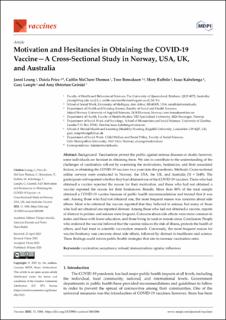Motivation and hesitancies in obtaining the COVID-19 vaccine – a cross-sectional study in Norway, USA, UK, and Australia
Leung, Janni; Price, Daicia; McClure-Thomas, Caitlin; Bonsaksen, Tore; Ruffolo, Mary; Kabelenga, Isaac; Lamph, Gary; Geirdal, Amy Østertun
Peer reviewed, Journal article
Published version
Permanent lenke
https://hdl.handle.net/11250/3096857Utgivelsesdato
2023Metadata
Vis full innførselSamlinger
Sammendrag
Background: Vaccinations protect the public against serious diseases or death; however, some individuals are hesitant in obtaining them. We aim to contribute to the understanding of the challenges of vaccination roll-out by examining the motivations, hesitancies, and their associated factors, in obtaining the COVID-19 vaccines two years into the pandemic. Methods: Cross-sectional online surveys were conducted in Norway, the USA, the UK, and Australia (N = 1649). The participants self-reported whether they had obtained one of the COVID-19 vaccines. Those who had obtained a vaccine reported the reason for their motivation, and those who had not obtained a vaccine reported the reason for their hesitancies. Results: More than 80% of the total sample obtained a COVID-19 vaccine because of public health recommendations and trusted that it was safe. Among those who had not obtained one, the most frequent reason was concerns about side effects. Most who obtained the vaccine reported that they believed in science, but many of those who had not obtained one reported distrust. Among those who had not obtained a vaccine, reports of distrust in policies and science were frequent. Concerns about side effects were more common in males and those with lower education, and those living in rural or remote areas. Conclusion: People who endorsed the vaccine believed that the vaccine reduces the risk of illness, protects the health of others, and had trust in scientific vaccination research. Conversely, the most frequent reason for vaccine hesitancy was concerns about side effects, followed by distrust in healthcare and science. These findings could inform public health strategies that aim to increase vaccination rates.

